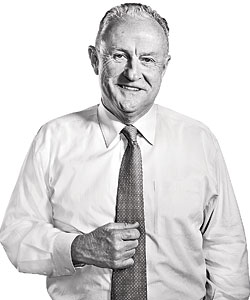Interview conducted and condensed by Jeff Bailey

As the largest industrial landlord in the Chicago area, CenterPoint invested $3 billion to turn thousands of acres at the old Joliet Arsenal into a vast intermodal rail facility, with millions of square feet of warehouse and manufacturing space. With 70 percent of U.S. rail freight passing through the Chicago area, you’re in the catbird seat. How did that happen?
I got a 12-year head start. [The federal government] had a little auction, and I was the only one who showed up. The Joliet Arsenal is a Superfund site. But arsenals have to be served by two Class I railroads, so Warren Buffett’s Burlington Northern Santa Fe and the Union Pacific [each now operating huge terminals at the arsenal] could both get to the site. Walmart has 3.4 million square feet [of warehouse space]. It unloads 100,000 containers a year [to truck goods to its stores]. You’re at I-55 and I-80. That’s Main and Main for the trucking industry.
Where’s all the freight coming from, and why does it pass through Chicago?
These two facilities are totally West Coast—[their freight comes from] Los Angeles, Long Beach, Oakland, Seattle, Vancouver. Chicago is the only place in the U.S. where the six Class I railroads meet. For the foreseeable future, we will be the distribution center. But we shouldn’t take it for granted.
The thousands of warehouse and distribution jobs created aren’t as high paying as the manufacturing jobs the region has lost, but they’re better than flipping burgers. What’s the job outlook at your rail properties for 2011 and beyond?
We will see more distribution jobs. And we’re hoping to see some light manufacturing and assembly jobs. Our owner, Calpers [the giant California state pension system], pays us extra for environmental gains. Each train takes 300 trucks off the road. But the second thing we’re supposed to do is create union construction jobs [with all the building at the arsenal]. And the railroads are hiring—thousands of jobs [nationally].
Routing trains to the arsenal and away from older rail yards in Chicago should help prevent the shipping bottlenecks that have occurred during every economic boom. Other benefits to the region?
Rahm Emanuel is going to get a lot of land to develop. The intermodal facilities in the city are going to pick up and come out here. Developed, that land will produce more property taxes for the city and more economic activity.
What’s the lead-time on these major projects? How do you protect yourself from downturns, or can you?
To do an intermodal from talking to opening is four years. It’s not for the faint of heart. You spend tens of millions of dollars optioning property before you have a railroad agreement. Burlington Northern was designed to be a 12-year build-out. Union Pacific is 15 years. We do economic modeling. We build in a recession or two. The balls was the Union Pacific. We broke ground in 2008 [as the economy was imploding]. They forged ahead. Now they’re already expanding.
In the United States, we have a great freight rail system and a crummy passenger rail system, the opposite of Europe. Would adding high-speed interstate rail, as Obama wants, screw up the freight system, as some have asserted?
I’m totally in favor of high-speed rail as long as it runs parallel—on separate tracks—to the freight system. But don’t screw up the freight system. It’s working too well now.
Photograph: Bob Stefko


